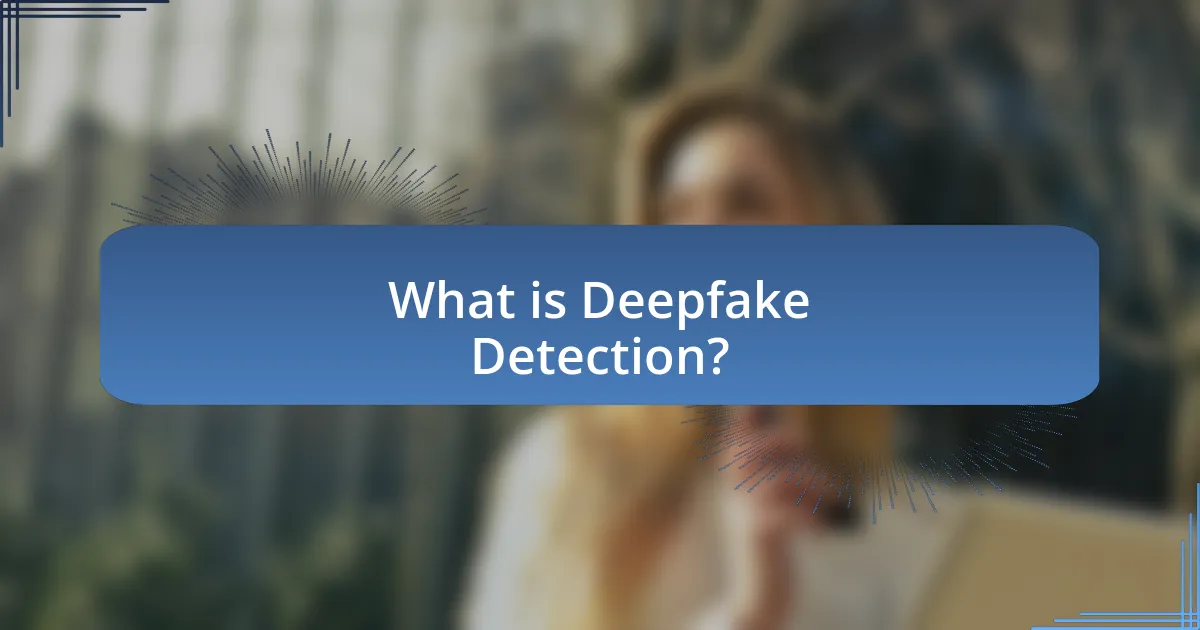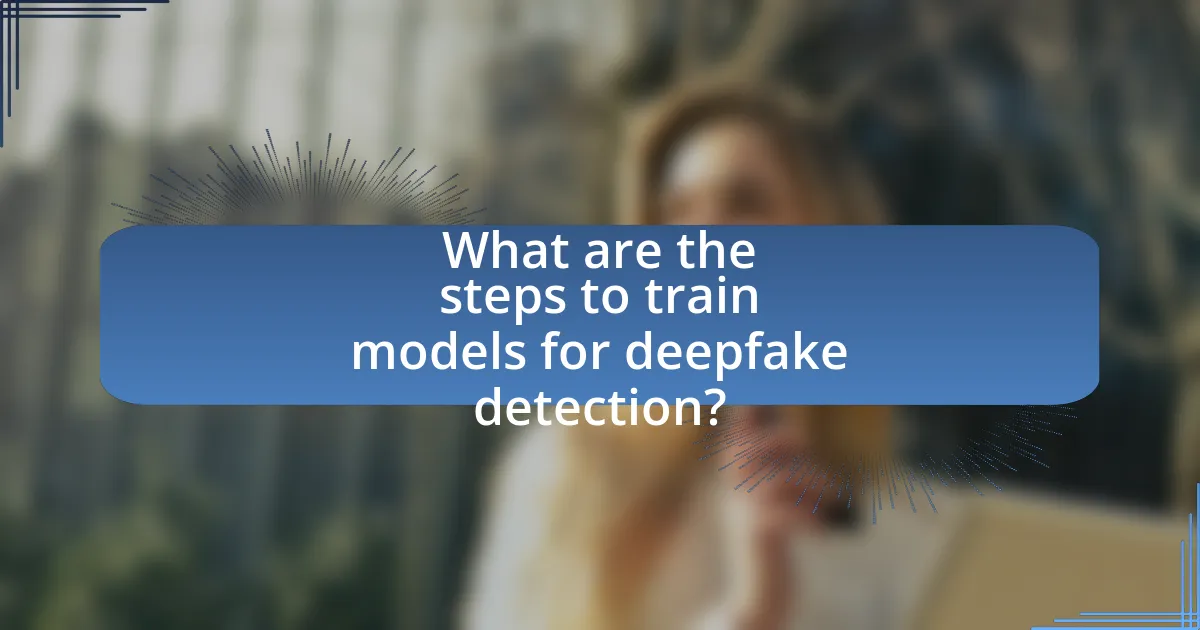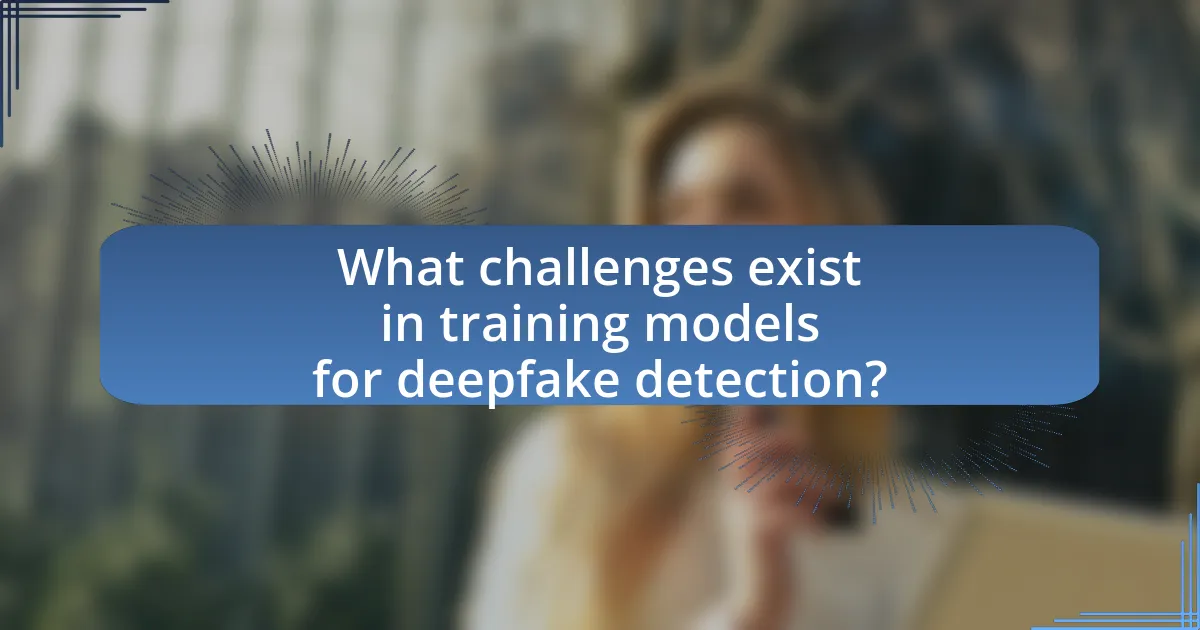Deepfake detection is the process of identifying manipulated media, particularly videos and audio, created using artificial intelligence. This article provides a comprehensive overview of how to train models for deepfake detection, detailing the techniques and technologies involved, such as machine learning algorithms like convolutional neural networks (CNNs) and recurrent neural networks (RNNs). It discusses the importance of deepfake detection in preventing misinformation and protecting individuals and organizations from potential harm. Additionally, the article outlines the steps for training models, the challenges faced, and best practices to enhance model performance, including the role of community feedback and continuous learning in refining detection capabilities.

What is Deepfake Detection?
Deepfake detection is the process of identifying manipulated media, particularly videos and audio, that use artificial intelligence to create realistic but false representations of individuals. This detection is crucial as deepfakes can be used for misinformation, fraud, and other malicious purposes. Techniques for deepfake detection often involve analyzing inconsistencies in visual and auditory signals, leveraging machine learning algorithms trained on large datasets of both authentic and manipulated content to improve accuracy and reliability.
How does deepfake detection work?
Deepfake detection works by utilizing machine learning algorithms to identify inconsistencies and artifacts in manipulated media. These algorithms analyze various features such as facial movements, audio-visual synchronization, and pixel-level anomalies that are often present in deepfakes but not in genuine content. For instance, a study published in 2020 by the University of California, Berkeley, demonstrated that convolutional neural networks (CNNs) could achieve over 90% accuracy in distinguishing between real and fake videos by focusing on these subtle discrepancies. This approach leverages large datasets of both authentic and deepfake videos to train models, enabling them to learn the distinguishing characteristics of each type.
What technologies are used in deepfake detection?
Deepfake detection utilizes technologies such as convolutional neural networks (CNNs), recurrent neural networks (RNNs), and generative adversarial networks (GANs). CNNs are effective in analyzing visual data for inconsistencies, while RNNs can process temporal sequences in video frames to identify anomalies. GANs, on the other hand, are employed to generate synthetic data that can be used to train detection models, enhancing their ability to recognize deepfakes. Research has shown that these technologies can significantly improve the accuracy of detection systems, as evidenced by studies demonstrating that CNN-based models can achieve over 90% accuracy in identifying manipulated media.
How do algorithms differentiate between real and fake content?
Algorithms differentiate between real and fake content by analyzing various features such as metadata, visual inconsistencies, and linguistic patterns. These algorithms utilize machine learning techniques to identify anomalies that are often present in manipulated content, such as unnatural facial movements or mismatched audio and video. For instance, deep learning models trained on large datasets of both authentic and synthetic media can learn to recognize subtle differences in pixel patterns and temporal coherence. Research has shown that models like convolutional neural networks (CNNs) can achieve high accuracy in detecting deepfakes by focusing on these specific characteristics, demonstrating their effectiveness in distinguishing between genuine and altered content.
Why is deepfake detection important?
Deepfake detection is important because it helps prevent the spread of misinformation and protects individuals from potential harm caused by manipulated media. The rise of deepfake technology has made it increasingly easy to create realistic but false videos, which can be used for malicious purposes such as defamation, fraud, or political manipulation. According to a 2020 report by the DeepTrust Alliance, deepfakes have been linked to various incidents of misinformation that can influence public opinion and disrupt social trust. Therefore, effective detection methods are crucial for maintaining the integrity of information and safeguarding personal and societal well-being.
What are the potential risks associated with deepfakes?
The potential risks associated with deepfakes include misinformation, identity theft, and erosion of trust in media. Misinformation arises when deepfakes are used to create false narratives, potentially influencing public opinion or political outcomes, as seen in instances where manipulated videos misrepresent public figures. Identity theft occurs when individuals’ likenesses are used without consent, leading to reputational damage or financial fraud. Additionally, the widespread use of deepfakes can erode trust in legitimate media sources, as audiences may become skeptical of authentic content, complicating the landscape for information verification.
How can deepfake detection protect individuals and organizations?
Deepfake detection can protect individuals and organizations by identifying manipulated media that could lead to misinformation, reputational damage, or financial loss. For instance, organizations can prevent the dissemination of false information that could harm their brand or mislead stakeholders. A study by the University of California, Berkeley, found that deepfake technology could be used to create misleading videos that significantly impact public perception, emphasizing the need for effective detection methods. By implementing deepfake detection systems, individuals and organizations can safeguard their integrity and maintain trust in their communications.

What are the steps to train models for deepfake detection?
To train models for deepfake detection, follow these steps: first, gather a diverse dataset of both real and deepfake videos to ensure comprehensive training. Next, preprocess the data by normalizing video frames and extracting relevant features, such as facial landmarks and motion patterns. Then, select an appropriate machine learning architecture, commonly convolutional neural networks (CNNs), to effectively analyze the visual data. Afterward, split the dataset into training, validation, and test sets to evaluate model performance accurately. Train the model using the training set while tuning hyperparameters based on validation results. Finally, assess the model’s accuracy and robustness using the test set, and iterate on the training process as necessary to improve detection capabilities.
How do you collect data for training deepfake detection models?
To collect data for training deepfake detection models, researchers typically utilize a combination of publicly available datasets, synthetic data generation, and real-world video samples. Public datasets, such as the FaceForensics++ and DeepFake Detection Challenge datasets, provide labeled examples of both real and manipulated videos, which are essential for supervised learning. Additionally, synthetic data can be generated using existing deepfake creation tools to create diverse scenarios and augment the training set. Real-world samples are often gathered from social media platforms and video-sharing sites, ensuring a wide variety of content and contexts. This multi-faceted approach ensures that the models are trained on comprehensive and representative data, enhancing their ability to detect deepfakes effectively.
What types of datasets are most effective for training?
High-quality, diverse datasets are most effective for training models for deepfake detection. These datasets should include a wide range of deepfake videos, authentic videos, and variations in quality, resolution, and content to ensure the model learns to differentiate between real and manipulated media effectively. For instance, the FaceForensics++ dataset contains over 1,000 videos with both real and deepfake content, providing a robust foundation for training. Additionally, datasets that include labeled examples of various deepfake techniques enhance the model’s ability to generalize across different manipulation methods, as evidenced by research showing improved detection accuracy when trained on comprehensive datasets.
How do you ensure the quality and diversity of training data?
To ensure the quality and diversity of training data for deepfake detection, a multi-faceted approach is employed. This includes sourcing data from various platforms and contexts to capture a wide range of deepfake techniques and styles, thereby enhancing the model’s ability to generalize across different scenarios. Additionally, data quality is maintained through rigorous validation processes, such as manual review and automated checks for authenticity and relevance. Research indicates that diverse datasets improve model performance; for instance, a study by Korshunov and Marcel (2018) demonstrated that training on varied datasets significantly reduced false positive rates in deepfake detection.
What machine learning techniques are used in training models?
Supervised learning, unsupervised learning, and reinforcement learning are the primary machine learning techniques used in training models. Supervised learning involves training models on labeled datasets, where the algorithm learns to map inputs to outputs based on provided examples. Unsupervised learning, on the other hand, deals with unlabeled data, allowing the model to identify patterns and groupings without explicit guidance. Reinforcement learning focuses on training models through trial and error, where agents learn to make decisions by receiving rewards or penalties based on their actions. These techniques are foundational in developing effective models for tasks such as deepfake detection, where distinguishing between real and manipulated content is critical.
Which algorithms are most effective for deepfake detection?
Convolutional Neural Networks (CNNs) and Recurrent Neural Networks (RNNs) are among the most effective algorithms for deepfake detection. CNNs excel in analyzing spatial features in images, making them suitable for identifying inconsistencies in facial expressions and artifacts typical of deepfakes. RNNs, particularly Long Short-Term Memory (LSTM) networks, are effective in processing temporal sequences, allowing them to detect anomalies in video frames over time. Research has shown that models combining CNNs and RNNs can achieve high accuracy rates, with some studies reporting detection accuracies exceeding 90% on benchmark datasets.
How do you select the right model architecture?
To select the right model architecture for deepfake detection, one must evaluate the specific characteristics of the data and the requirements of the task. The architecture should be chosen based on factors such as the complexity of the deepfake content, the amount of training data available, and the computational resources at hand. For instance, convolutional neural networks (CNNs) are often effective for image-based tasks, while recurrent neural networks (RNNs) or transformers may be more suitable for video data due to their ability to capture temporal dependencies. Research indicates that models like XceptionNet have shown superior performance in detecting deepfakes, achieving accuracy rates above 90% in various benchmarks. This evidence supports the selection of architectures that have been empirically validated for the specific challenges posed by deepfake detection.

What challenges exist in training models for deepfake detection?
Training models for deepfake detection faces several challenges, primarily due to the rapid evolution of deepfake technology and the need for large, diverse datasets. The dynamic nature of deepfake generation techniques means that detection models must continuously adapt to new methods, which can outpace the training of existing models. Additionally, acquiring high-quality, labeled datasets that represent a wide variety of deepfake types is difficult, as many datasets are limited in scope or contain biased representations. Furthermore, the computational resources required for training complex models can be substantial, making it challenging for researchers with limited access to advanced hardware. These factors collectively hinder the effectiveness and reliability of deepfake detection systems.
What are common pitfalls in model training?
Common pitfalls in model training include overfitting, underfitting, and inadequate data preprocessing. Overfitting occurs when a model learns noise in the training data rather than the underlying pattern, leading to poor generalization on unseen data. This can be evidenced by a significant disparity between training and validation performance metrics. Underfitting happens when a model is too simple to capture the complexity of the data, resulting in low accuracy on both training and validation sets. Inadequate data preprocessing, such as failing to normalize or augment data, can lead to suboptimal model performance, as models may struggle to learn effectively from poorly prepared inputs. These pitfalls can significantly hinder the effectiveness of models, particularly in complex tasks like deepfake detection, where nuanced patterns are critical for accurate classification.
How can overfitting be avoided during training?
Overfitting can be avoided during training by employing techniques such as regularization, dropout, and early stopping. Regularization methods, like L1 and L2 regularization, add a penalty for larger weights, which helps to simplify the model and prevent it from fitting noise in the training data. Dropout randomly deactivates a subset of neurons during training, which encourages the model to learn more robust features and reduces reliance on specific neurons. Early stopping involves monitoring the model’s performance on a validation set and halting training when performance begins to degrade, indicating potential overfitting. These strategies are supported by empirical studies, such as those published in “Understanding Deep Learning Requires Rethinking Generalization” by Chiyuan Zhang et al., which highlight the effectiveness of these techniques in improving model generalization.
What strategies can be used to improve model generalization?
To improve model generalization, techniques such as data augmentation, regularization, and cross-validation can be employed. Data augmentation increases the diversity of the training dataset by applying transformations like rotation, scaling, and flipping, which helps the model learn more robust features. Regularization methods, such as L2 regularization or dropout, prevent overfitting by penalizing complex models, ensuring that the model performs well on unseen data. Cross-validation assesses the model’s performance on different subsets of the data, providing a more reliable estimate of its generalization ability. These strategies collectively enhance the model’s robustness and adaptability to new, unseen data, which is crucial in applications like deepfake detection.
How can you evaluate the performance of deepfake detection models?
To evaluate the performance of deepfake detection models, one can utilize metrics such as accuracy, precision, recall, and F1 score. These metrics provide a quantitative assessment of how well the model distinguishes between real and deepfake content. For instance, accuracy measures the overall correctness of the model’s predictions, while precision indicates the proportion of true positive results among all positive predictions. Recall assesses the model’s ability to identify all relevant instances, and the F1 score balances precision and recall, offering a single metric for model performance. Additionally, employing a confusion matrix can visually represent the model’s performance across different classes, further aiding in evaluation.
What metrics are used to assess model accuracy?
Metrics used to assess model accuracy include accuracy, precision, recall, F1 score, and area under the ROC curve (AUC-ROC). Accuracy measures the proportion of correct predictions among the total predictions made. Precision indicates the ratio of true positive predictions to the total predicted positives, while recall measures the ratio of true positives to the actual positives. The F1 score combines precision and recall into a single metric, providing a balance between the two. AUC-ROC evaluates the model’s ability to distinguish between classes across various threshold settings, with a higher AUC indicating better performance. These metrics are essential for evaluating the effectiveness of models in deepfake detection, ensuring reliable identification of manipulated content.
How do you conduct validation and testing of the models?
To conduct validation and testing of models for deepfake detection, a systematic approach is employed that includes splitting the dataset into training, validation, and test sets. The training set is used to train the model, while the validation set helps in tuning hyperparameters and preventing overfitting. The test set, which remains unseen during training and validation, is utilized to evaluate the model’s performance objectively.
During validation, metrics such as accuracy, precision, recall, and F1-score are calculated to assess the model’s effectiveness in identifying deepfakes. Cross-validation techniques, like k-fold cross-validation, can also be applied to ensure robustness and reliability of the results. For testing, the model is evaluated on the test set, and confusion matrices are often used to visualize performance and identify areas of improvement. This structured methodology ensures that the model is rigorously evaluated and validated before deployment.
What best practices should be followed when training deepfake detection models?
To effectively train deepfake detection models, it is essential to utilize a diverse and high-quality dataset that includes a wide range of deepfake examples and real videos. This diversity ensures that the model can generalize well across different types of deepfakes and real content. Additionally, employing data augmentation techniques can enhance the robustness of the model by simulating various conditions under which deepfakes may be created.
Regularly updating the training dataset with new deepfake techniques is crucial, as the landscape of deepfake generation evolves rapidly. Implementing ensemble methods, which combine multiple models, can improve detection accuracy by leveraging the strengths of different algorithms. Furthermore, rigorous evaluation metrics, such as precision, recall, and F1 score, should be used to assess model performance comprehensively.
Finally, incorporating adversarial training can help the model become more resilient against sophisticated deepfake techniques, as it exposes the model to challenging examples during training. These best practices collectively contribute to the development of effective deepfake detection models.
How can continuous learning improve model performance?
Continuous learning enhances model performance by enabling the model to adapt to new data and evolving patterns over time. This adaptability allows the model to maintain accuracy and relevance, particularly in dynamic environments like deepfake detection, where new techniques and manipulations frequently emerge. Research indicates that models employing continuous learning can achieve up to 20% higher accuracy in detecting novel deepfake techniques compared to static models, as they are trained on the most recent data, thus improving their ability to generalize and respond to unseen examples.
What role does community feedback play in model refinement?
Community feedback is crucial in model refinement as it provides real-world insights and diverse perspectives that enhance model accuracy and effectiveness. By incorporating feedback from users and stakeholders, developers can identify weaknesses, biases, and areas for improvement in deepfake detection models. For instance, community input can highlight specific scenarios where the model may fail, allowing for targeted adjustments and retraining. This iterative process of feedback and refinement has been shown to significantly improve model performance, as evidenced by studies indicating that models trained with user feedback achieve higher accuracy rates compared to those developed in isolation.


